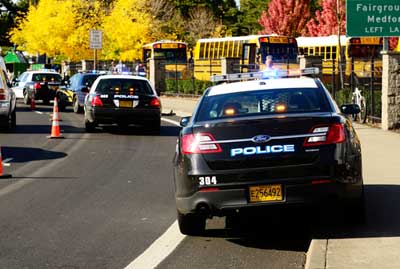
Washington – In the next few months, every high school in Modesto, Calif., might get its own designated cop to help keep students safe – and it’s far from alone nationwide.
In an attempt to keep schoolchildren safer, the U.S. Department of Justice on Friday said it was handing out $44 million in grants to help provide 356 school resource officers to 141 cities and counties around the country. Some grants recipients had been named previously; Friday’s announcement included all winners. While the grants go to law enforcement agencies, they are intended to help place more police officers in schools.
In Modesto, for example, the grant is for $1 million to fund eight new school resource officers in the California city’s school district.
“Not only do they deter crime, but they provide opportunities for positive relations between students and law enforcement,” said Karen Servas, a Modesto City School District grant writer.
The district collaborated with the Modesto Police Department in the grant-writing process, and the partners got the amount they asked for. Details for spending the grants have not yet been made; in addition, the Modesto City Council has to approve the program, which requires grantees to match every dollar two-to-one.
The grants represent the latest push from the Obama administration to make the nation’s schools safer. A month after the tragedy at Sandy Hook Elementary School, where 20 children and six adults were shot and killed, President Barack Obama launched a campaign to reduce gun violence nationwide. Included were proposals to mandate background checks for gun buyers and bans on high-capacity magazines.
The administration also aimed to put up to 1,000 new school resource officers and counselors in schools across the country, as well as to make sure every school has an emergency management plan. Although many of the president’s ideas have been rebuffed by Congress, the ideas for emergency plans by schools and additional safety officers are in place.
A school resource officer is a sworn law enforcement officer with the authority to make arrests and a license to carry a weapon in schools. Resource officers can also mentor and advise students, as would a guidance counselor.
According to the National Association of School Resource Officers, there are more than 10,000 resource officers in the U.S. Based on a surge in training requests, memberships and actual new officers across the country, the association said that school-based policing is the fastest growing area of law enforcement.
The grant money for the school officers came from the existing Department of Justice Office of Community Oriented Policing Services – COPS – grant program. This year, COPS officials favored police departments that had applied for school resource officers, although it still funded many of its traditional grants.
Friday’s announcement detailed $125 million in grants, of which $44 million went to the schools program.
“In the wake of past tragedies, it’s clear that we need to be willing to take all possible steps to ensure that our kids are safe when they go to school,” Attorney General Eric Holder said in a statement announcing the awards. “These critical investments represent the Justice Department’s latest effort to strengthen key law enforcement capabilities and to provide communities with the resources they need to protect our young people. Especially in a time of increased challenges and limited budgets, our top priority must always be the safety and well-being of our children.”
Even so, some experts say that more police in schools is not the right measure to increase school safety.
Marc Schindler, the director of the Justice Policy Institute, a nonprofit advocacy group that seeks to reduce the use of incarceration, believes it’s a shortsighted policy.
“There is no indication that the presence of (resource officers) makes schools safer,” he said in an interview. “In fact, there’s research supporting that there’s likely unwanted consequences.”
In 2011, the institute published a report, “The Case Against Police in Schools,” pointing out that schools with the presence of officers are more likely to have arrests for minor offenses, among other things.
Schindler said that although the intention of the Obama administration is right, more police just won’t do any good.
“In terms of safe schools, research favors a supporting and nurturing environment based around counselors, social workers and teachers, which makes kids feel that they’re in a safe place,” he said. “Because of rare but high-profile tragedies like Newtown, many are concerned about school safety. I have kids in school and I want them to be safe. . . . Unfortunately, things that sound good are not always the best response.”
Join us in defending the truth before it’s too late
The future of independent journalism is uncertain, and the consequences of losing it are too grave to ignore. To ensure Truthout remains safe, strong, and free, we need to raise $43,000 in the next 6 days. Every dollar raised goes directly toward the costs of producing news you can trust.
Please give what you can — because by supporting us with a tax-deductible donation, you’re not just preserving a source of news, you’re helping to safeguard what’s left of our democracy.